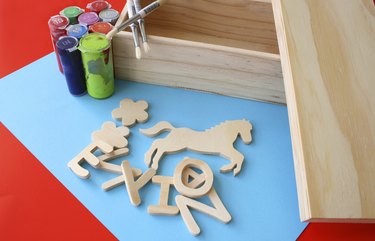
Wood is fairly forgiving when you use paint to decorate it. Since wood is porous, the paint soaks in a little, creating a shallow bond with the wood, unlike materials such as plastic that require special paints or primers to get the paint to adhere. Water-based paints such as acrylic and latex adhere well to wood, but no matter which paint you end up using, proper preparation of the wood surface is the key to a beautiful paint treatment, whether you're painting designs on the wood or coating the entire project with one paint color.
Worthwhile Wood Preparation
Video of the Day
You may be tempted to dip the paintbrush right into the paint, skipping the preparation so you can get right to the fun part of the project. While the paint may adhere to wood in just about any condition, sanding and prepping the project ahead of time ensures your painted handiwork stays intact. Sand wood such as an unfinished jewelry box or wooden cigar box with a fine-grit sandpaper to remove splinters and imperfections; then wipe it down with a tack cloth to remove the dust. Sanding is also necessary if the wood has been previously painted or varnished; sanding scuffs up the surface to make it more receptive to paint. On previously finished wood pieces, you may wish to prime the wood as well to ensure sufficient paint coverage.
Video of the Day
All-Around Acrylics
Acrylic paint, sometimes simply called craft paint, works well on wood, doesn't take long to dry and has little odor, compared to oil-based paints. Paintbrushes used with acrylics can be used again and again, as long as they are rinsed off in water before the paint hardens. Acrylics may be mixed together to create your own interesting shades and paint effects, such as an ombre or rainbow wooden serving tray, or a swirling galaxy illustration with glow-in-the-dark stars on a wooden bench or table. Acrylic craft paints are one of the most widely available paint types at a craft store, with numerous color options to choose from. They are also inexpensive when purchased in small quantities such as 1-ounce bottles, ideal for assorted small craft projects.
Large-Scale Latex
While latex paints are typically used for large projects such as walls, ceilings or even the outside of a house, they also work well for covering large wood craft projects such as decorating plain wooden crates or dressing up an old chest of drawers with a painted seascape, turning it into functional art furniture. Latex paint behaves much like acrylic paint; it emits little odor and can be cleaned up with water. On a large-scale project, latex paint may end up costing less because acrylics are typically sold by the ounce in small containers. A quart or so of a latex paint generally costs less than the same amount of acrylic paint in a similar color.
Enamel Options
Some enamel brush-on and spray paints designed for crafting also work well on wood. Enamel paint provides a glossier finish than regular acrylic craft paint, which sometimes has a slightly chalky appearance when dry. Water-based enamel formulations take the best traits of acrylics, such as easy cleanup with soap and water, and add the high-gloss characteristics of enamel paints. Check the enamel craft paint package before purchasing, as some enamels are geared toward non-porous surfaces such as glass and ceramics, while other multi-purpose formulas adhere to wood as well.